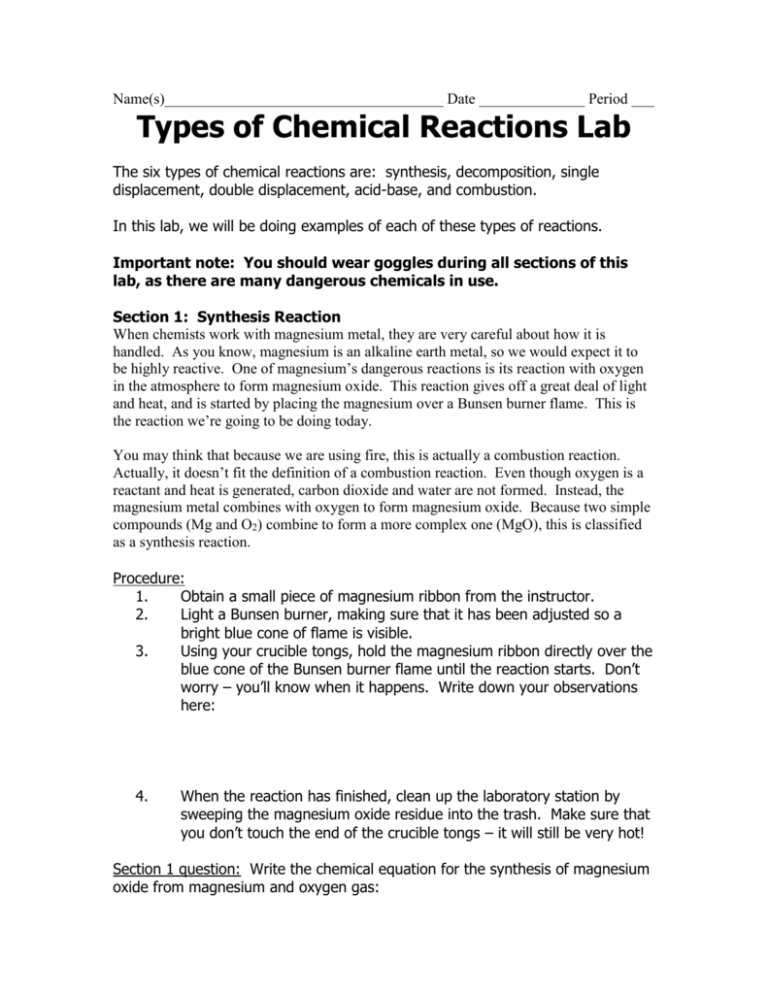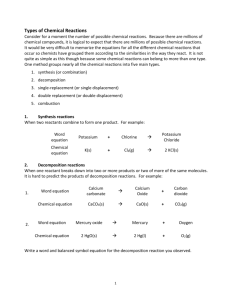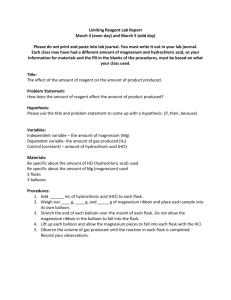Name(s) - Cathedral High School
advertisement

Name(s)_____________________________________ Date ______________ Period ___ Types of Chemical Reactions Lab The six types of chemical reactions are: synthesis, decomposition, single displacement, double displacement, acid-base, and combustion. In this lab, we will be doing examples of each of these types of reactions. Important note: You should wear goggles during all sections of this lab, as there are many dangerous chemicals in use. Section 1: Synthesis Reaction When chemists work with magnesium metal, they are very careful about how it is handled. As you know, magnesium is an alkaline earth metal, so we would expect it to be highly reactive. One of magnesium’s dangerous reactions is its reaction with oxygen in the atmosphere to form magnesium oxide. This reaction gives off a great deal of light and heat, and is started by placing the magnesium over a Bunsen burner flame. This is the reaction we’re going to be doing today. You may think that because we are using fire, this is actually a combustion reaction. Actually, it doesn’t fit the definition of a combustion reaction. Even though oxygen is a reactant and heat is generated, carbon dioxide and water are not formed. Instead, the magnesium metal combines with oxygen to form magnesium oxide. Because two simple compounds (Mg and O2) combine to form a more complex one (MgO), this is classified as a synthesis reaction. Procedure: 1. Obtain a small piece of magnesium ribbon from the instructor. 2. Light a Bunsen burner, making sure that it has been adjusted so a bright blue cone of flame is visible. 3. Using your crucible tongs, hold the magnesium ribbon directly over the blue cone of the Bunsen burner flame until the reaction starts. Don’t worry – you’ll know when it happens. Write down your observations here: 4. When the reaction has finished, clean up the laboratory station by sweeping the magnesium oxide residue into the trash. Make sure that you don’t touch the end of the crucible tongs – it will still be very hot! Section 1 question: Write the chemical equation for the synthesis of magnesium oxide from magnesium and oxygen gas: Section 2: Decomposition Reaction Some of the most violent chemical reaction are decomposition reactions. Sodium azide is the chemical in airbags that spontaneously decomposes into sodium nitride and nitrogen gas when sparked with an electrical charge. In this section, we will see a very common decomposition reaction. You’ve noticed that soda starts bubbling when you open the bottle, even though there was no bubbling before the bottle was opened. This is due to the decomposition of carbonic acid, H2CO3, into water and carbon dioxide. When the bottle is closed, pressure inside the bottle keeps the reaction from occurring. When you open the bottle, pressure is released and the reaction starts. When the bottle goes flat, all the carbonic acid has completely reacted and the reaction is over. Procedure: 1. Using a spatula, place a small amount of sodium carbonate, Na2CO3, into a clean, dry 50 mL beaker. 2. Using a graduated cylinder, pour 10 mL of hydrochloric acid, HCl, into the same 50 mL beaker. 3. Write down your observations here: 4. Clean up – the beaker may be cleaned by pouring the contents into the sink and rinsing with water. Section 2 question: When sodium carbonate and hydrochloric acid are combined, the make carbonic acid, which then decomposes. Write the equation for the decomposition of carbonic acid, H2CO3, into water and carbon dioxide. Section 3: Single displacement reactions Single displacement reactions are very important in the area of electrochemistry. Without single displacement reactions, we wouldn’t have batteries of any kind. In the reaction you will be observing, zinc, Zn, reacts with hydrochloric acid, HCl, to form hydrogen gas and zinc chloride. When this reaction takes place, electrons move from zinc to hydrogen. In a battery, these electrons are used to produce electricity. Procedure: 1. Fill a small Erlenmeyer flask to approximately the 10 mL mark with hydrochloric acid, HCl. 2. Place 1 small piece of zinc metal into the HCl. Write down your observations here: 3. Clean up – clean up the lab by pouring the zinc and hydrochloric acid into a labeled waste beaker. Make sure to get any unreacted zinc out of the flask. Section 3 questions: Write the equation for the reaction of hydrochloric acid with zinc to form zinc chloride and hydrogen gas. What do you think the bubbles were that you saw being formed? Section 4: Double displacement reactions Double displacement reactions are extremely common in chemistry. Many common reaction in industry and nature involve double displacement reactions. For example, the shells of many sea animals are made of calcium carbonate, formed from double displacement reactions within the animals. The double displacement reaction you will do today was once instrumental in the manufacture of paints for household products. You will no doubt be able to guess what extremely common school product was painted with this pigment when you see it being formed. Procedure: 1. In a watch glass, place 5 drops of potassium iodide, KI, using the labeled dropper. 2. To this watch glass, add 5 drops of lead (II) nitrate, Pb(NO3)2, using the labeled dropper. Write your observations here: 3. Clean up – pour the mixture into a labeled waste beaker. Rinse off the watch glass with water after disposing of precipitate. Section 4 Questions: 1) What common school product do you think was painted with this pigment? 2) Why do two colorless solutions form a colored compound when they are combined? What do you think has happened? 3) Write the equation for the reaction of potassium iodide, KI, with lead (II) nitrate, Pb(NO3)2, to produce lead (II) iodide with potassium nitrate, KNO3. Section 5: Acid-base reactions Acid-base (neutralization) reactions are responsible for many reactions in biochemistry and atmospheric chemistry. One example of acid-base chemistry is acid rain. Acid rain occurs when acidic gases are released by power plants and dropped hundreds of miles from their source, killing fish and plants. In this section, you will see the acid-base reaction of hydrochloric acid, HCl, with sodium hydroxide, NaOH. Procedure: 1. Pour 5 drops of hydrochloric acid, HCl, into a watch glass. Add one drop of indicator solution (phenolphthalein) to the watch glass. The color you see indicates the presence of an acid. What color indicates that an acid is present? 2. Slowly add sodium hydroxide, NaOH, to the watch glass containing HCl, drop by drop, until the color of the solution changes. The new color indicates base is present in the solution. What color is the new solution? 3. Clean up – rinse the solution on the watch glass with water down the drain. Section 5 Questions: 1. Antacids such as Tums, Rolaids, and Maalox work by the same means that baking soda does. Do you think this explains why they work so quickly? Explain. 2. Acid-reducing medications such as Pepcid AC, Tagament HB, and Axid AR work by a completely different mechanism that does not neutralize stomach acid. Instead, these medications work by making the stomach secrete less acid in the first place. Do you think this explains why they work so slowly? Explain. 3. Write the equation for the reaction of hydrochloric acid, HCl, with sodium hydroxide, NaOH, to form sodium chloride, NaCl, and water. Section 6: Combustion reactions Modern life depends on combustion reactions. The energy we use in our homes is generated by power plants that burn coal. The energy that powers our cars is generated by the combustion of gasoline. The heat that cooks food on a gas stove is generated by the combustion of natural gas. Without combustion reactions, there would be nowhere near enough energy to keep society running. One of the main things we as a society are trying to do is to find new sources of energy that don’t require the combustion of non-renewable resources such as coal, gas, oil, or wood. Unfortunately, solar power is not yet efficient enough to produce industrial amounts of power, wind power is not reliable, hydroelectric power has already been fully exploited, and environmental activists have kept nuclear power from being adequately utilized. Until technical or social hurdles can be removed, we will be dependent on a shrinking supply of fuel to run our society. Methanol is a fuel that can be used to power both family and high-performance automobiles. We will be observing the combustion of methanol, CH3OH, in this section. Procedure: 1. Pour about 10 drops of methanol, CH3OH, into a watch glass. 2. Using crucible tongs to hold the match, carefully light the methanol, making sure to keep your hand away from the fire. Write your observations for this reaction here: Section 6 questions: 1. What did the methanol fire look like? Did it look like other flames you have seen before, or were there some differences? Explain. 2. Methanol fires are far less hot than gasoline fires. This makes them safer to use in automobiles, but less capable of producing large amounts of energy. Keeping this in mind, do you think that methanol is a good source of fuel for automobiles? Explain. 3. Write the reaction for the combustion of methanol with oxygen gas to produce carbon dioxide and water.









